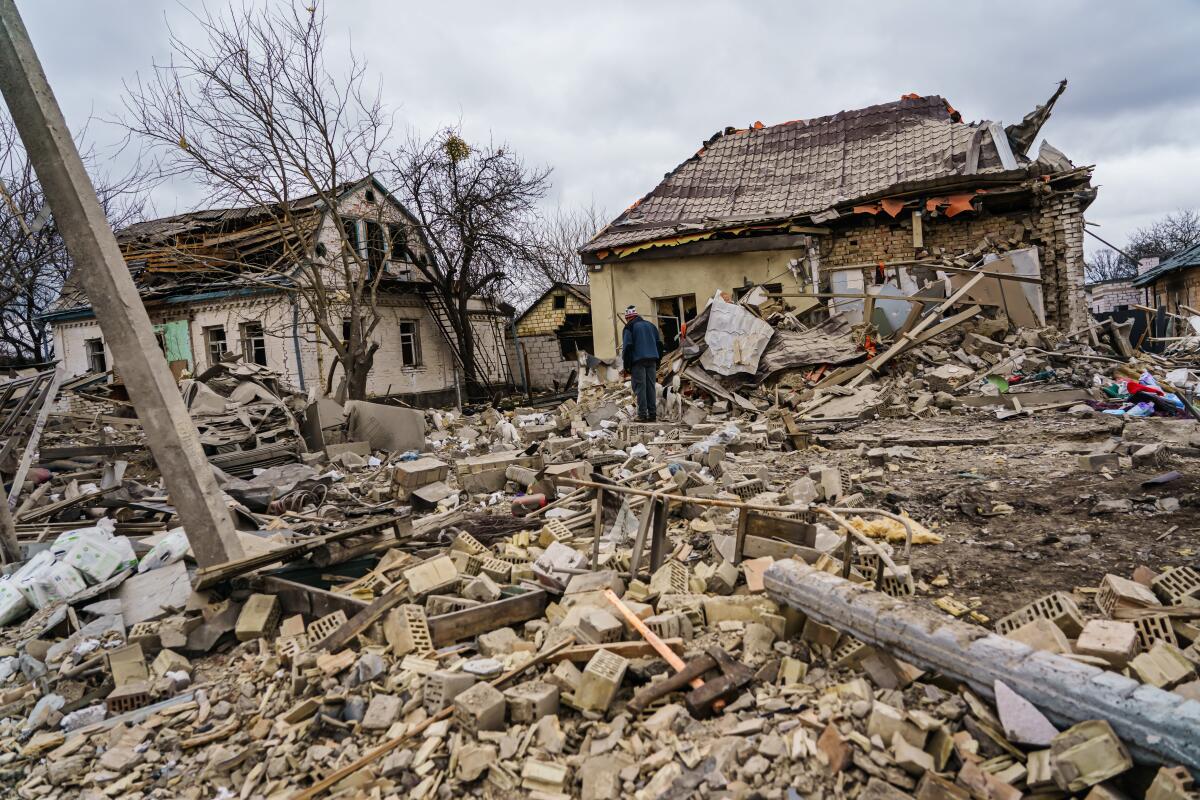Op-Ed: Stop financing Putin’s war machine. Cut off Russia’s oil and gas sales

- Share via
Europe and the United States are united against Putin’s brutal invasion of Ukraine, yet those countries currently pay Russia upward of $1 billion per day for oil and natural gas. Revenue from oil- and gas-related taxes and tariffs accounted for 45% of Russia’s federal budget in January.
Such payments fund an evil war machine focused on killing Ukrainian civilians, even when they have been granted safe passage.
Russian oil and gas are now the moral equivalent of blood diamonds.
Western energy purchases can be stopped if the U.S. steps up and leads the way. Done properly, the damage to Russia would be swift and devastating, while the effect on energy costs for us and our allies is likely to be minor.
Russia currently sells 5 million barrels of oil on average every day, part of a world market where prices move rapidly. Its total revenue for exported crude oil and refined products amount to around $700 million per day. Over half of this oil is bought by the European Union and about a quarter by China.
Most Russian gas is sold through three pipelines: through the Baltic, across Ukraine and across Belarus. Some of this gas is under long-term delivery contracts, but a considerable amount is sold on spot markets. The EU and Britain combined buy nearly 70% of Russian gas, and the U.S. buys none.
Over the last 12 months, Russia has weaponized its gas deliveries by curtailing offerings to the spot market to drive up prices and lower the amount stored in Western Europe. As a result, levels of gas stored in Germany are low for this time of year.
In 2020, the latest year for which the U.S. Energy Information Administration has complete figures, our country produced 11.3 million barrels of crude oil per day and imported 5.9 million barrels. Russia supplied 540,000 barrels of crude, which was 9.2% of imported oil but just 3.1% of what the EIA regards as the nation’s crude oil supply. The latest monthly data, for November 2021, indicate Russia’s share remains about the same.
There are three potential approaches for an oil embargo.
In one scenario, the U.S. bans the purchase of Russian oil but does nothing else. American oil companies can easily switch to other suppliers. Since oil is priced based on the expectations for supply and demand in a world market, there would be little direct impact if the U.S. chose to buy more, for example, from Saudi Arabia and some existing Saudi customers received Russian oil instead.
In this case, the U.S. would pay nothing to Russia, the world price for crude should not move, the gasoline price at your local pump would also be unchanged, and Russia would receive the same revenue but now from other countries. There might be some symbolic value to this policy, but it would be meaningless in its economic effect.
A second option is for the U.S. to ban crude oil purchases from Russia and use “secondary sanctions” to prohibit any financial institution doing business in dollars from also facilitating purchases of Russian oil anywhere in the world. The oil market transacts in dollars, so these secondary sanctions would have real bite.
No sanctions regime is perfect, and the Russians might even be able to sell all 5 million daily barrels, but they would have to sell at a heavy discount. Shell bought a shipment of Russian oil a few days ago, paying nearly $30 per barrel less than the going rate for non-blood oil, and now faces calls for a consumer boycott. Even the most unscrupulous customers will demand bigger discounts from Russian oil traders.
In this case, the global supply of oil remains the same, but Russia loses revenue due to the blood discount. This might drive the price Russia receives down toward the marginal cost of production in western Siberia, which estimates suggest is $40 or lower per barrel. Russian oil revenue could fall by as much as half.
The price in the non-blood oil part of the market may not change much and, if so, U.S. gasoline prices are also unlikely to move. Ideally, Saudi Arabia and other OPEC countries can be persuaded to increase production as needed, as an additional buffer against disruption.
A third, more complete scenario would be to ban crude purchases, impose secondary sanctions and persuade the Europeans to buy less gas. European nations have a problem because they cannot easily switch away from the pipeline supply to alternative sources, but Russia also has a problem because almost all its gas cannot be switched to serve non-European markets.
Some European countries may need external funding support to install more efficient equipment, ramp up electricity generally from renewables and buy liquefied natural gas from sources other than Russia. The International Monetary Fund can provide loans on favorable terms. Germany will finance its own transition away from Russian gas. Other nations, such as Italy, may struggle more. It’s important that the EU be generous in supporting its members to make this change.
In this scenario, Russian oil revenues would fall dramatically and its gas revenues would also decline. Payments for oil would barely cover production costs, which means no revenue for the government budget. Daily payments for gas should also drop sharply. As the weather warms in Europe, getting to zero purchases of Russian gas could be quite possible.
The financial sanctions already in place are important but, by themselves, they will not degrade Russian fossil fuel production capacity. The critical issue now is to save Ukrainian lives by cutting off all possible revenue to the Russian state.
Choose the third scenario: Buy nothing from Russia.
Simon Johnson is a professor at MIT Sloan and former chief economist at the International Monetary Fund. Oleg Ustenko is economic advisor to President Volodymyr Zelensky of Ukraine.
More to Read
A cure for the common opinion
Get thought-provoking perspectives with our weekly newsletter.
You may occasionally receive promotional content from the Los Angeles Times.










